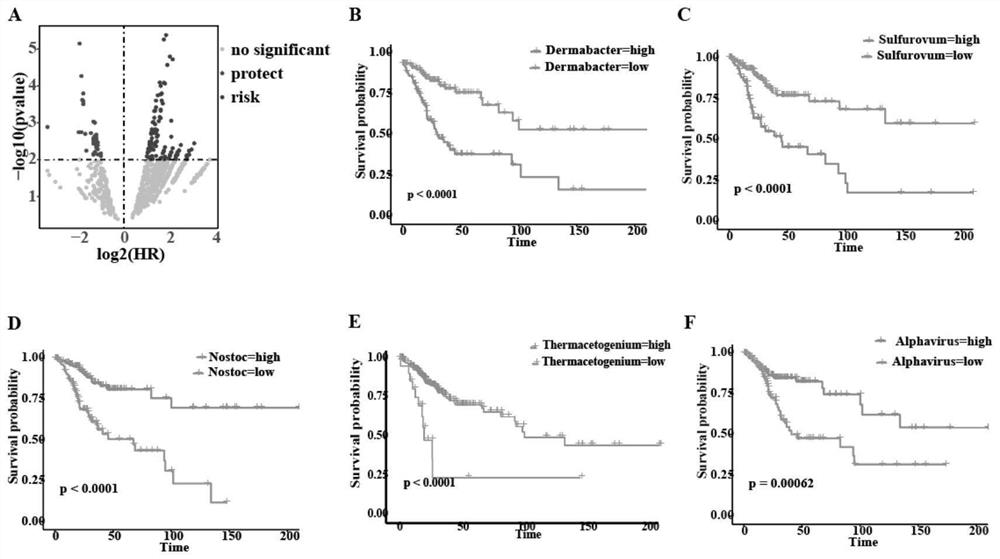Cervical cancer prognostic marker microorganism and its application in the preparation of cervical cancer prognosis prediction and diagnosis products
A cervical cancer and microbial technology, applied in the biological field, to avoid excessive medical treatment
- Summary
- Abstract
- Description
- Claims
- Application Information
AI Technical Summary
Problems solved by technology
Method used
Image
Examples
Embodiment 1
[0047] Embodiment 1, cervical cancer prognostic marker microorganism and its screening method
[0048] 1. The influence of the abundance of related microorganisms in cervical cancer squamous cell carcinoma samples on the prognosis of cervical cancer
[0049] Using the clinical information of 248 patients with cervical cancer squamous cell carcinoma and the abundance of related microorganisms in the TCGA database, the impact of the abundance of these 1406 microorganisms on the prognosis of cervical cancer was further evaluated by using the R language survival and surmier packages; the specific steps include:
[0050] 1. Find the optimal cut-off value of the abundance of the above 1406 microorganisms, and divide them into high-abundance and low-abundance groups according to the optimal cut-off value of their expression, using Cox regression analysis, Kaplan-Meier survival curve and log rank assay to evaluate the impact of high or low abundance of these microorganisms on overall ...
Embodiment 2
[0062] Embodiment 2, cervical cancer prognosis risk prediction system and its establishment method
[0063] 1. Cervical cancer prognosis risk prediction system
[0064] Based on the results of Example 1, we developed a cervical cancer 5-microbial prognostic scoring system. We applied a step-by-step canonical discriminant analysis to identify microbial markers capable of discriminating patient outcomes with 100% accuracy, and finally identified a scoring system consisting of 5 specific cervical cancer prognostic microorganisms that Including: Dermabacter, Sulfurovum, Nostoc, Thermacetogenium and Alphavirus. The information of each microorganism is shown in Table 2.
[0065] The above-mentioned cervical cancer prognostic scoring system uses the prediction score to calculate the survival probability of the patient. The scoring system was defined as a linear combination of microbial abundances based on the coefficients of the Cox hazard function. Calculated as follows:
[006...
Embodiment 3
[0079] Embodiment 3, cervical cancer prognosis risk prediction system
[0080] An embodiment of the present invention provides a cervical cancer prognosis risk prediction system, the system comprising:
[0081] a processor and a memory coupled to the processor, the memory storing instructions that when executed by the processor use the following steps:
[0082] According to the input of the DNA or mRNA abundance of the cervical cancer prognostic marker microorganism into the prediction system described in Example 2, the cervical cancer prognosis risk prediction score is obtained.
PUM
 Login to View More
Login to View More Abstract
Description
Claims
Application Information
 Login to View More
Login to View More - R&D
- Intellectual Property
- Life Sciences
- Materials
- Tech Scout
- Unparalleled Data Quality
- Higher Quality Content
- 60% Fewer Hallucinations
Browse by: Latest US Patents, China's latest patents, Technical Efficacy Thesaurus, Application Domain, Technology Topic, Popular Technical Reports.
© 2025 PatSnap. All rights reserved.Legal|Privacy policy|Modern Slavery Act Transparency Statement|Sitemap|About US| Contact US: help@patsnap.com



